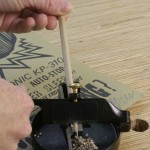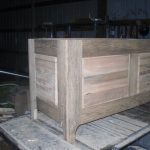We may receive a commission when you use our affiliate links. However, this does not impact our recommendations.
Those of you who routinely send me e-mails when I write about something “not woodworking related,” stop reading. You will not be amused – even though this involves a sharp blade and tiny shavings. No, really. It’s not about woodworking. You won’t like it. Go away.
 A few years ago, Christopher Schwarz stumbled across David Rees’s “Artisanal Pencil Sharpening” site. For $15, Rees sends a sharpened pencil in a plastic tube with a protective tip over the hand-sharpened point, along with a certificate of authenticity and the bagged pencil shavings. Plus, at the time, for $50 your order would include a limited-edition print on acid-free paper, signed and numbered by the artist (the prints are now sold out).
A few years ago, Christopher Schwarz stumbled across David Rees’s “Artisanal Pencil Sharpening” site. For $15, Rees sends a sharpened pencil in a plastic tube with a protective tip over the hand-sharpened point, along with a certificate of authenticity and the bagged pencil shavings. Plus, at the time, for $50 your order would include a limited-edition print on acid-free paper, signed and numbered by the artist (the prints are now sold out).
It sounds like a colossal joke. It is not. As it says on Rees’s web site: “If you think it’s a joke, why don’t you poke yourself with your newly sharpened pencil? Or better yet, don’t – because it’ll really hurt.”
Chris went whole hog and ordered the pencil plus the print, and he gave them to me as a gift. I’ve yet to take the pencil out of it’s protective wrappings, because I’m afraid I’ll immediately break off the hand-sharpened point – which I could, of course, then send back to Rees for re-sharpening. (Plus, seeing that tubed pencil and print atop my bookcase simply makes me smile.)
 But I fear Lee Valley Tools may put Mr. Rees and other artisanal pencil sharpeners out of business with the “Little Shaver” pencil sharpener – a contemporary version of a 1910 product for which Edward L. McDivitt held the patent (you can read more about it on the Lee Valley site).
But I fear Lee Valley Tools may put Mr. Rees and other artisanal pencil sharpeners out of business with the “Little Shaver” pencil sharpener – a contemporary version of a 1910 product for which Edward L. McDivitt held the patent (you can read more about it on the Lee Valley site).
When the Little Shaver showed up on our conference table this morning, I had the same reaction I had upon first seeing Rees’s site: This has to be a joke. It is not.
 As we sat in our weekly Monday morning meeting, I found myself using the oddly addictive tool. It’s pretty simple: Slip a pencil into the support notch, then slide the blade down the point, rotate the pencil and repeat. It does get a pencil far sharper than any other method I’ve used. (So of course I poked myself with my newly sharpened pencil. It really hurts.)
As we sat in our weekly Monday morning meeting, I found myself using the oddly addictive tool. It’s pretty simple: Slip a pencil into the support notch, then slide the blade down the point, rotate the pencil and repeat. It does get a pencil far sharper than any other method I’ve used. (So of course I poked myself with my newly sharpened pencil. It really hurts.)
Still – it comes with no certificate of authenticity, and the shavings aren’t as pretty. I think there’s still room for the David Reeses of the world (his site is well worth a visit).
Here are some supplies and tools we find essential in our everyday work around the shop. We may receive a commission from sales referred by our links; however, we have carefully selected these products for their usefulness and quality.









Handwork is relaxing and all but you can’t make a living at it: http://www.youtube.com/watch?v=EKL6elkbFy0
Only in America. Reminds me of the excursions during Boy Scout summer camp, where the newbies were sent out to other encampments to borrow a left-handed smoke shifter, and bacon stretcher. The poster is very cool, if not somewhat ironic – which is probably the intent. The Lee Valley device is a remarkable modern reproduction. That item does tempt me a bit, with five youngsters in school. A great show-and-tell piece to-boot, but alas, it is not equipped with a blade stop.
The importance of the pencil sharpener has always been underated. I remember a story from Werner von Braun when he was working for Adolph Hitler designing the V1 and V@ rockets during World War 2. Money was very tight and only available for items vital to the project. One day he ordered a “milling machine” to be used for shaping small wooden dowels. When his request was approved he went out and bought a pencil sharpener.
Al Limiero
I remember a featured skit on Saturday Night Live called “The Anal Retentive Fisherman” whose host was so obsessively compulsive about every minute detail – he had a knitted cozy for his filet knife and discarded the scales, skin and guts in a neatly wrapped and tied package to be thrown away – that he never actually finished his project of cooking a Bass filet. I wonder what an MMPI would reveal about the guy who invented this pencil sharpening device; it’s a little creepy…although strangely appealing.
Does this come in a left-hand version? Or is it convertible? Either way it’s on my wish list!
I was apprenticed to a master sharpener at a very young age. I have memories of long hours grinding away at these writing devices attempting to reach the pinnacle of perfection. Handed a box of these instruments I would inspect them one at a time and ever so gingerly insert them in the sharpener hoping for perfect. I would grind slowly and with great anticipation I would remove them only to find an imperfect form. Of course I blamed the sharpener but my master reminded me that any tool even a bad one can do great things in the right hands,’ it’s all in the technique’ I was told. After many attempts I was close to reaching my goal but then the bell rang, detention was over I could go home after I cleaned the black board erasers.
Don B.
I saw this and thought it was cool as heck. I almost bought it but I think I would have gotten in trouble.
Far from being the death knell of my business, I am delighted to read of the new “Little Shaver,” as I have used the original version before and found it delightful! I will certainly consider adding one of these devices to my kit of pencil-pointing tools.
Gary Roberts, I do accept PayPal and I hope to make a customer out of you! http://www.artisanalpencilsharpening.com
Best regards,
David Rees
Artisanal Pencil Sharpening
I was sorely tempted to send a pencil I have that’s special, made of ground up US dollar bills. I couldn’t bring myself to do it. I wonder if he takes Paypal?
Alas! I can now become the sharpest pencil in the drawer!
I haven’t yet investigated the optimal back bevel – but the blade does not fit in my Eclipse (yeah, I tried).
Now how about sharpening the little iron? Oilstones? Waterstones? Back bevel? Strop? Camber? Can you hold the thing in an Eclipse-type guide? Should the primary bevel be 25 degrees or what? Now we’re talking woodworking.